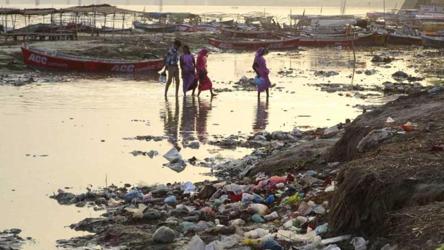Alarmed at post-Kumbh mess in Prayagraj, NGT warns of epidemic
The tribunal had appointed a committee to see to it that the Ganga did not get polluted further during the Kumbh Mela. The present order of the NGT is based on this committee’s report.

NGT,Kumbh Mela,Prayagraj
The NGT report predicted a rise in cases of acute diarrhoea, enteric fever, viral hepatitis and cholera. The tribunal said groundwater too had been polluted.
The National Green Tribunal (NGT) has expressed unhappiness over the solid waste that has accumulated in Prayagraj after the 49-day Kumbh Mela, bringing the city to the verge of an epidemic. The Kumbh Mela began on January 15 and concluded on March 4.
Pulling up the UP chief secretary for the severe lapse, the NGT has instructed him to appear before it on April 26 and take urgent steps to dispose of the solid waste and fix accountability of officers in this regard.
The tribunal had appointed a committee to see to it that the Ganga did not get polluted further during the Kumbh Mela. The present order of the NGT is based on this committee’s report.
According to the report filed by the committee headed by Justice Arun Tandon, the NGT mentioned the situation in the area was alarming and it needed to be dealt with on an urgent basis to avoid the spread of epidemics.
A bench headed by NGT chairperson Justice Adarsh Kumar Goel said accountability must be fixed at the ground level and personal supervision by senior level officers ensured.
Quoting the UP chief secretary, the NGT report said 60,000 metric tonnes (mt) of untreated solid waste got collected at the Baswar solid waste treatment plant. Out of this, 18,000 mt waste was generated at the Kumbh Mela even as the plant was not operational since September 2018.
The NGT report predicted a rise in cases of acute diarrhoea, enteric fever, viral hepatitis and cholera.
The tribunal said groundwater too had been polluted.
“Dirty water from toilets was being collected in kutcha pits. The base of the soak pits had not been lined and the dirty water could percolate underground,” the report said.
NGT said the Ganga was left in the lurch. “The committee found that a large number of toilets were constructed in camps on the Arail side, very close to the river.
The Rajapur Sewage Treatment Plant (STP) received excess sewage than the installed capacity. Only 50% of the Rajapur drain was being treated through geo tube (it extracts solid waste from the waste going in the drain so that only water enters it) and the remaining 50 per cent was being permitted to enter the Ganga without treatment,” NGT said.
Additional municipal commissioner, Prayagraj, Amrendra Verma, said the private firm ‘Hari Bhari’ was entrusted with the task of processing of solid waste at the Baswar plant and a notice had already been served on the corporation.
“The municipal corporation is not directly responsible for disposal of solid waste as the private firm has been allotted a tender for the job. Since the firm failed to do its work efficiently, a notice has been issued for completing the task at the earliest. Municipal Commissioner Ujjawal Kumar was directly monitoring waste disposal of the Kumbh Mela but he is on leave and will be back after a couple of days,” he added.
Divisional Commissioner, Prayagraj, Ashish Kumar Goel, who is also the chairman of the Kumbh Mela Authority—the main organizing body of the fair— said that facts regarding disposal of solid waste would be placed before the tribunal.
“We have done our best. Responsibility will be fixed on officials for the laxity. By any means, this mela was better than any of the previous ones,” he said. The tribunal said the sewage treatment plant at Salori too was not working satisfactorily.
“It had more sewage than it could treat. The geo tube was not working satisfactorily and 50 per cent of the sewage from the drain was trapped and the rest was going into the Ganga,” the tribunal said.
Coming down hard on the much talked-about geo-tube technology, NGT dubbed it a failure.
NGT said, “The Mawaiya Nala, where the technology has been adopted, had a bypass because of which untreated water from the drain entered the Ganga. The committee also found that there existed a big, dirty water pond at Parmarth Niketan Arail and human excreta was seen floating in it.”
Similarly, the report stated Mansuthia, another drain, also had a bypass, due to which untreated waste met treated waste just before it was allowed to enter into the Ganga. “Creation of bypass at places where geo-tube technology had been adopted has let dirty water enter the river,” NGT mentioned.
According to AK Gupta, the amicus curie in the Re-Ganga Pollution case, he had submitted an application in the Allahabad High Court carrying a list of 83 drains in the city.
Forty-six of these drains remained untapped during the Kumbh Mela, dumping untreated sewage water in the Ganga and the Yamuna.
“I had apprised Divisional Commissioner Ashish Goel several times about untapped drains but he not only chose to ignore the same, but also kept me out of every committee supervising the same,” he added.
However, Ingio Contractors Private Ltd, the firm that implemented the geo-tube technology for filtering sewage waste before letting it enter the river, has decided to challenge the NGT report.
“We completely disagree with the findings of the NGT committee as far as geo-tube technology for filtering the sewage water is concerned. We will contest the findings tooth and nail and justify our working before the tribunal,” said Rajnish Mehra, director of the firm.
Further, the committee found several other violations of NGT orders for preserving any river. For instance, 36 temporary ponds dug up on the bank of the Ganga had no lining and some of them still contained dirty water.
The order also hit out at the Mela administration for being non-cooperative with the supervisory committee on several issues, including non-installation of public toilets built right on the banks of the Ganga.
“Pucca constructions were being raised on the Yamuna bank and despite notices, the authorities did not disclose as to who had sanctioned the maps/building plans. The administration was trying to “hoodwink the cleaning of waste from the soak pits and septic tanks and ponds,” NGT said.




